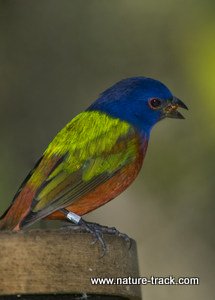Technology Gives Birders a Competitive Edge

If a birder spies a rare beauty like this painted bunting, news can spread through the birding community faster than a peregrine's stoop. Technology has taken birding to a new level.
Believe it or not, birding and hunting are closely allied. Both pursuits involve stalking shy creatures and learning their habits. Smart birders and hunters learn their quarry’s habitats and life histories and work tirelessly to properly identify the animal before either taking a shot or adding it to a list.
Hunters and birders, however, differ in one fundamental way: hunters go to great lengths to hide their favorite spots and birders can’t wait to share. For hunters, the world must be paved in No Name Mountains and Notellum Creeks, and white lies are the expected norm.
Birders, on the other hand, want to be the first to report the exact location of the latest sighting and the more obscure the species the better. For birders, being able to report a rare bird is the equivalent of hanging a stuffed trophy on the wall.
I used to think that hunters were the most technologically burdened group of outdoor enthusiasts. For instance, hunters seem to be more susceptible to fashion than a runway model. Skill is replaced with gadgetry and these days, a pocket full of batteries is more important than a handful of ammunition.
Birders have benefitted from the gizmo addiction of hunters. Advanced cameras, optics, camouflage, blinds, calling devices and more are all useful to birders.
Birders have carried it even further, becoming the most techno-savvy group of outdoor enthusiasts. Their use of mobile devices, social media and computers is second to none.
Like hunters, birders use their cell phones to find the coordinates for their location and take quality photos or HD video. But, when identification has been verified, the birder can instantly post photos and locations to his or her favorite website or social media and mass text friends without even leaving the field, creating a linked community unlike any the outdoors has ever seen.
Technology has changed the face of birding. On a recent morning, a truck pulled up next to mine at Market Lake Wildlife Management Area and the driver and I exchanged stories and sightings. It seemed old-fashioned. I learn a lot visiting with people in the field, but anymore it is like using a slide rule when a calculator is in my pocket.
Birders who have embraced technology can move like a flock of starlings from one exciting sighting to the next. There is even a Yahoo! Group named Idaho Birders Linked Electronically and a Facebook page, Idaho Birders, which provide instant feedback.
In a way, it seems like cheating. A birder can build an impressive life list by just paying attention to the continual stream of electronic information and targeting only the hotspots. No need to really learn the behaviors, migration timing or other biology.
But it isn’t all self-serving. Through websites such as www.ebird.org, birders can log their observations in a common database. This citizen science helps to document declining species and shifts in distribution from things such as climate change.
With birders, I suspect last week’s plea for a simpler outdoor life will fall on deaf ears. I don’t expect anything different from hunters either. Outdoor technology is here to stay. It will be interesting to see how it changes both pursuits.